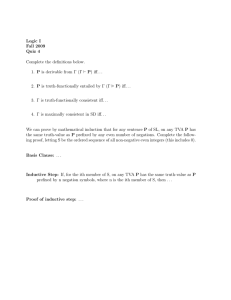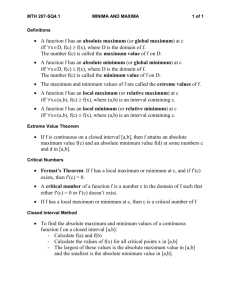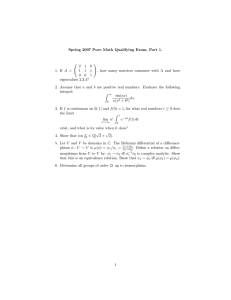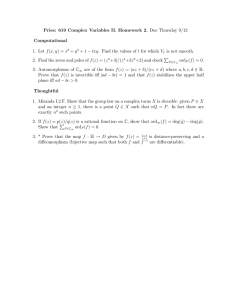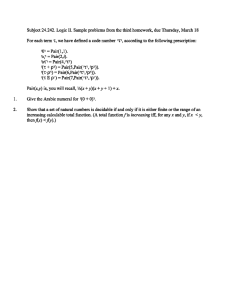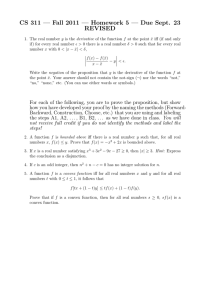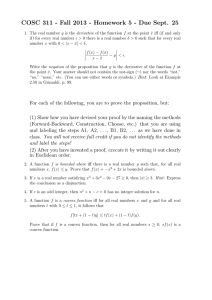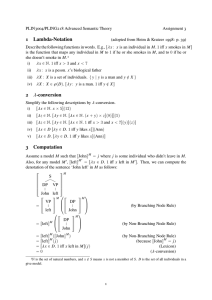14.12 Game Theory Lecture 2 Decision Theory Muhamet Yildiz
advertisement
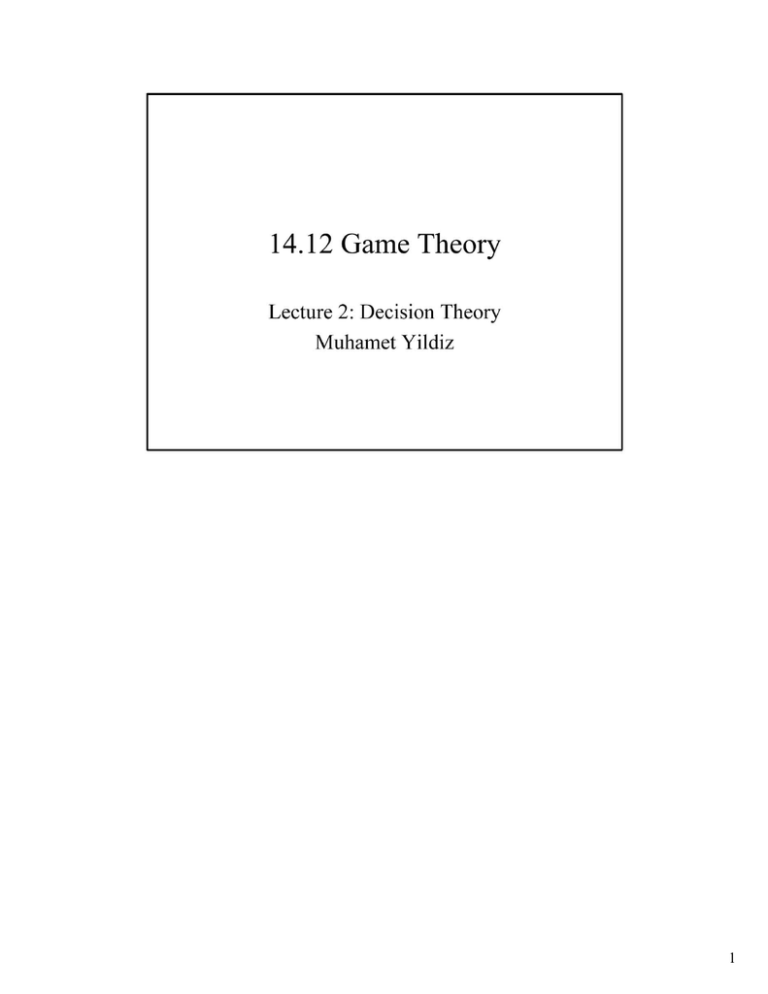
14.12 Game Theory
Lecture 2: Decision Theory
Muhamet Yildiz
1
Road Map
1. Basic Concepts (Alternatives, preferences, ... )
2. Ordinal representation of preferences
3. Cardinal representation - Expected utility
theory
4. Modeling preferences in games
5. Applications: Risk sharing and Insurance
2
Basic Concepts: Alternatives
• Agent chooses between the alternatives
• X = The set of all alternatives
• Alternatives are
- Mutually exclusive, and
- Exhaustive
3
Example
• Options = {Algebra, Biology}
•
•
•
•
•
X= {
a = Algebra,
b = Biology,
ab = Algebra and Biology,
n = none}
4
Basic Concepts: Preferences
• A relation
~
(on X) is any subset of X xX.
• e.g.,
~*= {( a,b ),( a,ab ),( a,n),(b,ab ),(b,n),(n,ab)}
• a
•
~
b - (a, b) E ~.
is complete iff Vx,y
~
x~y
•
~
E
or y~x.
is transitive iff Vx,y,z
[x~y
X,
E
and y~z]
X,
===? X~Z.
5
Preference Relation
Definition: A relation is a preference relation
iff it is complete and transitive.
6
Examples
Define a relation among the students in this
class by
• x T y iff x is at least as tall as y;
• x M y iffx's final grade in 14.04 is at least
as high as y's final grade;
• x H y iff x and y went to the same high
school;
• x Y y iff x is strictly younger than y;
• x S y iff x is as old as y;
7
More relations
• Strict preference:
x > y ~ [ x ~ y and y
';f x ],
• Indifference:
x~y~[x
~
~
y and y
x].
8
Examples
Define a relation among the students in this
class by
• x T y iff x is at least as tall as y;
• x Y y iff x is strictly younger than y;
• x S y iff x is as old as y;
9
Ordinal representation
Definition: ~ represented by u : X ----+ Riff
x ~ y <=> u(x) > u(y) VX,YEX. (OR)
10
Example
''l" ** -{(a,b),( a,ab ),( a,n),(b,ab ),(b,n),(n,ab ),( a,a),(b,
b ),(ab,ab ),(n,n) }
is represented by u** where
u**(a) =
u**(b) =
u**(ab)=
u**(n) =
11
Exercises
• Imagine a group of students sitting around a round
table. Define a relation R, by writing x R y iff x sits
to the right of y. Can you represent R by a utility
function?
• Consider a relation:;:': among positive real numbers
represented by u with u(x) = x 2 .
Can this relation be represented by u*(x) = X1 /2?
What about u**(x) = lIx?
12
Theorem - Ordinal Representation
Let X be finite (or countable). A relation ~ can
be represented by a utility function U in the
sense of (OR) iff ~ is a preference relation.
If U: X ---+ R represents ~, and iff: R ---+ R is
strictly increasing, thenfcU also represents ~.
Definition: ~ represented by u : X --* Riff
x ~ y <=> u(x) 2: u(y) 'IIX,YEX (OR)
13
Two Lotteries
~
.3
$ 1000
1001 /
.007
. 999~
$ 1M
$0
15
Cardinal representation - definitions
• Z = a finite set of consequences or prizes.
• A lottery is a probability distribution on Z.
• P = the set of all lotteries.
• A lottery:
1001 /
.007
. 999~
$1M
$0
16
Cardinal representation
• Von Neumann-Morgenstern representation:
/
Alottery ~
(inP)
I
Expected value of
u underp
p>-q ~ LU(Z)p(z) > Lu(z)q(z)
,
ZEZ
y
U(P)
ZEZ
,
'~~y~---'
>
U(q)
17
VNMAxioms
Axiom A1:
~
is complete and transitive.
18
VNMAxioms
Axiom A2 (Independence): For any p,q,rEP,
and any a E (0,1],
ap + (l-a)r > aq + (l-a)r <=> p > q.
q
P
~
.5
.5
.5
.5
>
$1000
.~$IM
.5
$100
>
A trip to Florida
.99999
.5
$0
A trip to Florida
19
VNMAxioms
Axiom A3 (Continuity): For any p,q,rEP with
p >- q, there exist a,bE (0,1) such that
ap + (I-a)r >- q & p >- bq + (I-b) r.
20
Theorem - VNM-representation
A relation ~ on P can be represented by a
VNM utility function u : Z ---+ R iff ~
satisfies Axioms AI-A3.
u and v represent ~ iff v = au + b for some
a > 0 and any b.
21
Exercise
• Consider a relation ~ among positive real
numbers represented by VNM utility
function u with u(x) = x 2.
Can this relation be represented by VNM
utility function u*(x) = x1l2?
What about u**(x)
=
l /x?
22
Decisions in Games
Bob
R
L
A lice
• Outcomes:
Z = {TL,TR,BL,BR}
T
• Players do not know each
other's strategy
B
•
T
P
p
=
Pr(L) according to Alice
TL
TR
-p
o0
BL
BR
23
Example
• T?= B
> 14; BL ~ BR
• uA(B ,L) = uA(B,R) = 0
• P uA(T,L) + (l-p) uA(T,R) > 0 ~ p > 14;
~P
• (114) uA(T,L) + (3/4) uA(T,R)
• Utility of A:
L
R
T
3
-1
B
0
0
=
0
24
Attitudes towards Risk
• A fair gamble:
--
~ x
I-p
px+(1-p)y = O.
Y
• An agent is risk neutral iff
he is indifferent towards all fair gambles.
• He is (strictly) risk averse iff
he never wants to take any fair gamble.
• He is (strictly) risk seeking iff
he always wants to take fair gambles.
25
• An agent is risk-neutral iffhis utility function is
linear, i.e., u(x) = ax + h.
• An agent is risk-averse iff his utility function is
concave.
• An agent is risk-seeking iff his utility function is
convex.
26
Risk Sharing
• Two agents, each having a utility function u
with u(x)= -f; and an "asset:" .~
~
$100
- - - . $0
.5
• For each agent, the value ofthe asset is
5.
• Assume that the outcomes of assets are
independently distributed.
27
- If they form a mutual fund so that each
agent owns half of each asset, each gets
~
$ 100
114
o---,,-,-,
1I2=--. $50
~
$0
-The Value of the mutual fund for an agent is
(1/4)(100)1 /2 + (1/2)(50)1 /2 + (1/4)(0)1 /2
:::: 10/4 + 712 = 6
28
Insurance
• We have an agent with u(x) =
7
X1l2
and
$IM
.5 - $0
• And a risk-neutral insurance company with
lots of money, selling full insurance for
"premium" P.
29
Insurance -continued
• The agent is willing to pay premium P A
where
(1M-PA )1 /2 > (1 /2)(1M) 1/2 + (1 /2)(0) 112
=
500
1.e.,
P A < $lM - $250K = $750K.
• The company is willing to accept premium
PI > (1I2)(1M) = $500K.
30
MIT OpenCourseWare
http://ocw.mit.edu
14.12 Economic Applications of Game Theory
Fall 2012
For information about citing these materials or our Terms of Use, visit: http://ocw.mit.edu/terms.

